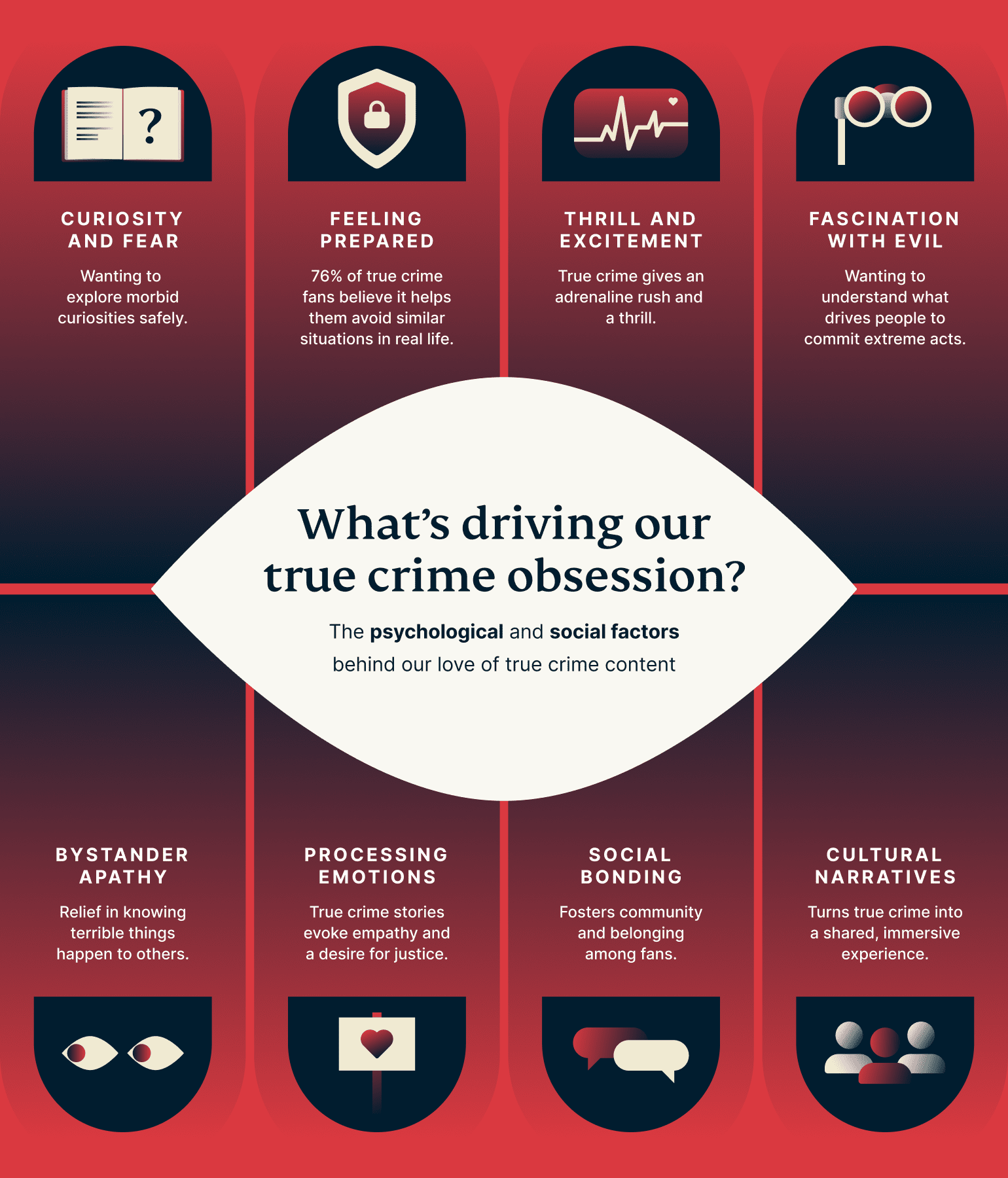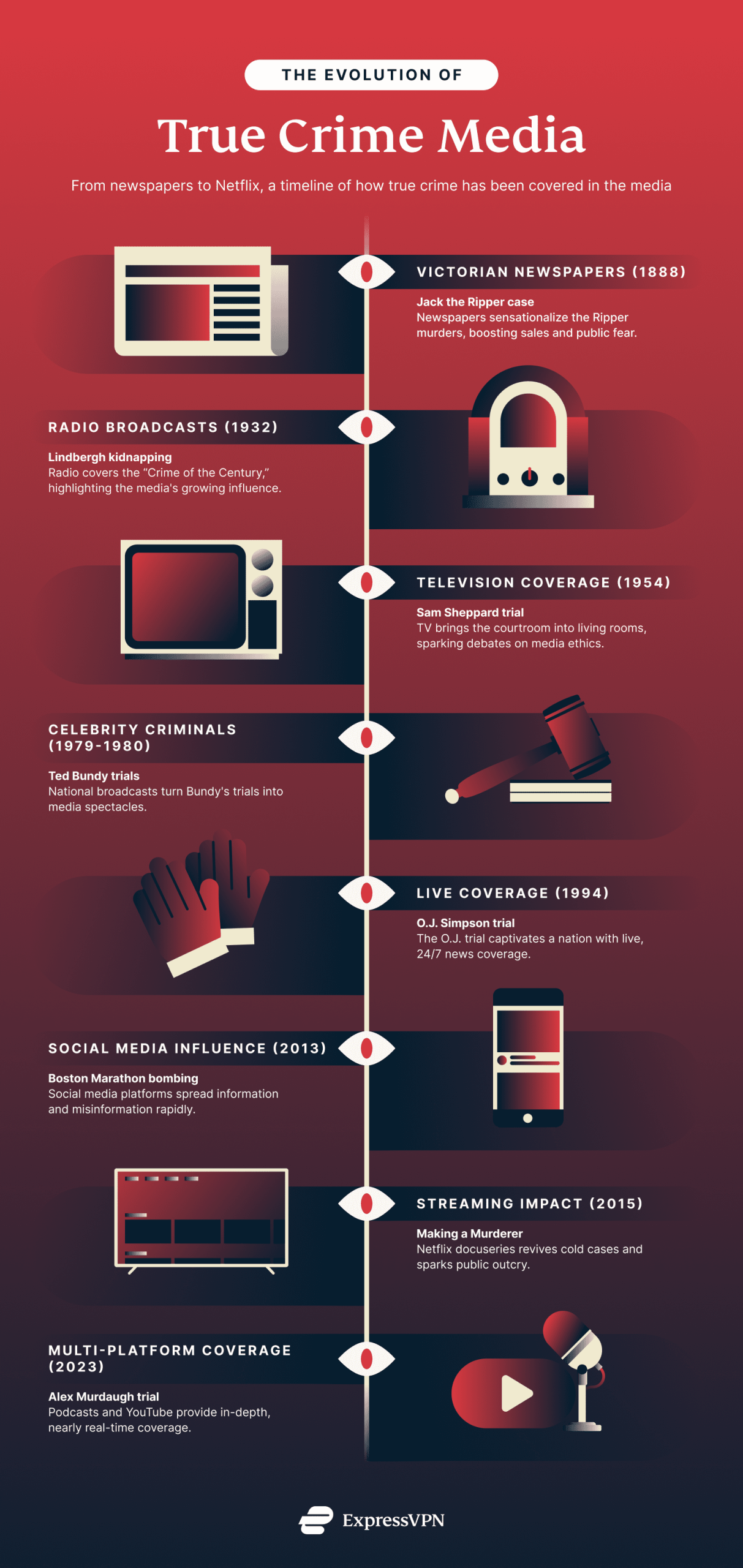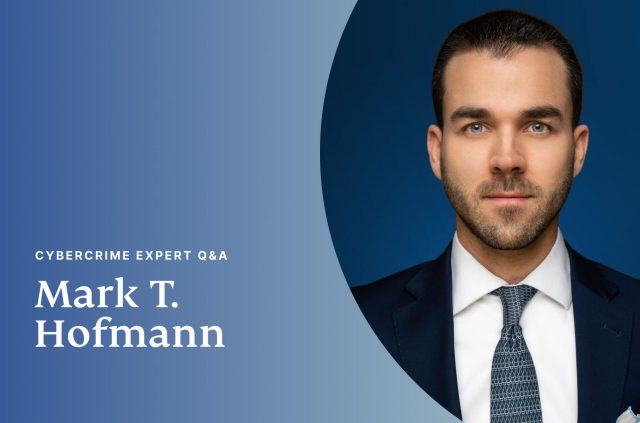How technology feeds a global obsession with true crime

- Technology has given us front-row seats to global true crime stories, intensifying our fascination with the genre.
- The evolution of true crime media spans from Victorian newspapers to modern streaming platforms.
- Social media and online forums have made collaborative investigation possible, with users coming together to solve cold cases.
- Tools like a VPN router allow true crime fans to access exclusive content from different countries.
- Psychological factors like curiosity, fear management, and thrill-seeking drive our obsession with true crime.
- Ethical storytelling in true crime is the key to respecting victims and their families, highlighting the need to create content with sensitivity.
Think of the last time you fell down the rabbit hole of a true crime docuseries. One minute you’re settling in with a snack, and the next, you're six episodes deep, piecing together clues like a detective. Thanks to platforms like Netflix, Max, and YouTube, these stories from every corner of the globe are now just a click away, beaming sinister tales and mind-boggling mysteries right into our living rooms.
But there's more to this craze than just binge-watching. Technology has sparked a new generation of sleuthing—where amateur detectives on online forums and DNA databases can crack cold cases that have stumped authorities for decades. And while we get our detective fix, there's a cost. The same platforms that help solve crimes and increase awareness also risk turning real-life losses into public entertainment.
Join us as we explore what drives society’s obsession with true crime, questioning not just the who and the how, but the why and at what cost.
How true crime media has evolved
Our obsession with the darker tales of human nature isn’t anything new, but the way we feed this fascination has changed dramatically over the years. Remember the days of huddling around the radio or catching the evening news for updates on the latest headline-making trial? Now, the evolution of media has reshaped not only how we access these stories but also how we engage with them.
From the early days of sensationalist newspapers to the modern era of streaming services, here are eight notable cases that show how true crime media has evolved.
1. Victorian sensationalism: Jack the Ripper (1888)
The Jack the Ripper case is a prime example of early media sensationalism. In late Victorian London, newspapers like The Star and The Daily Telegraph played a key role in creating a public frenzy. They provided lurid details of the murders, speculated wildly about the killer's identity, and published letters purportedly from the Ripper. This not only fed public fear but also established the template for true crime reporting as a means to boost newspaper sales.
2. Media circus: the Lindbergh kidnapping (1932)
Fast forward to 1932, and America found its “Crime of the Century” with the Lindbergh kidnapping. Newspapers and radios buzzed non-stop, tracking every twist and turn of the case of 20-month-old Charles Lindbergh Jr.’s disappearance. The sheer scale of the media frenzy ushered in new laws aimed at keeping the press in check around high-publicity crimes, highlighting just how powerful and influential the media had become in shaping public discourse and the legal landscape.

3. Televised justice: the Sam Sheppard case (1954)
Dr. Sam Sheppard, accused of murdering his wife, was a landmark in media influence on justice. His trial was one of the first to be extensively covered on television, leading to widespread public debate about media ethics and the presumption of innocence. The U.S. Supreme Court later ruled that Sheppard did not receive a fair trial partly because of the media circus atmosphere, highlighting the ongoing tug-of-war between a free press and a fair trial.
4. Celebrity criminals: the Ted Bundy trials (1979-1980)
Ted Bundy was a chilling example of a media sensation turning dark. Known for his unsettling charm, Bundy attracted a fan club that was bizarrely captivated by him despite his gruesome crimes. This peculiar fascination turned his trials into full-blown media events; it was the first trial ever to be broadcast nationally and watched by millions. This underscored how the media could transform even the most serious criminal trials into must-watch television—raising questions about the impact of this type of exposure on public perception and justice.

5. Saturation coverage: O.J. Simpson trial (1994)
The O.J. Simpson trial took media influence to a new level. Televised live, it became a national obsession, blending celebrity culture with true crime in ways previously unseen. The extensive coverage not only shaped public perception but also raised questions about racial tension, police misconduct, and the celebrity “halo” effect (where famous people can do no wrong), underscoring the complex relationship between media narratives and societal issues.
6. Social media accuracy: the Boston Marathon bombing (2013)
The Boston Marathon bombing tested the speed and accuracy of social media and also highlighted its profound impact on law enforcement and public safety narratives. As the chaos unfolded, platforms like Twitter (now X) were essential for emergency communications, but the rapid spread of misinformation also led to wrongful accusations and panic. During the immediate aftermath, users on Reddit's r/findbostonbombers subreddit and other social media platforms mistakenly identified several innocent individuals as suspects, including Sunil Tripathi who had gone missing a month before the terror attack. This led to severe consequences, including harassment and threats to the families of those wrongly accused.

The event catalyzed changes in how law enforcement uses social media, pushing agencies to improve their online presence and interaction with the public during emergencies. It also spurred discussions about the responsibilities of digital platforms in regulating content to prevent the viral spread of harmful misinformation.
7. Docuseries impact: Making a Murderer (2015)
Making a Murderer changed the game for true crime docuseries. When it hit Netflix, suddenly everyone was talking about Steven Avery, Wisconsin’s Manitowoc County, and whether justice was truly served. Avery, a man previously exonerated by DNA evidence, was accused of a new crime—the murder of photographer Teresa Halbach—under questionable circumstances. The series sparked actions such as petitions, debates on legal forums, and real-world scrutiny of the case it portrayed. It also thrust viewers into a national discussion about justice and transparency. Through Making A Murderer, Netflix proved that a well-made docuseries could educate and provoke thought and action on a massive scale.
8. Multi-platform coverage: the Alex Murdaugh trial (2023)
Alex Murdaugh, a former attorney in South Carolina accused of murdering his wife and son, among other crimes, saw his trial extensively covered across various digital platforms. From traditional news broadcasts to podcasts and YouTube channels analyzing every development, the case showed the current state of true crime media: a 24/7, multi-platform spectacle. The Murdaugh trial, coupled with its elements of financial fraud and dramatic personal downfall, hooked a global audience and highlighted how today's digital platforms keep us gripped over long stretches.
How tech is revolutionizing true crime narratives
As new technologies and platforms continue to emerge, they’re giving us a different experience of true crime today. Here’s how:
24/7 news cycle
The media’s relentless coverage has amplified our fascination with true crime. Since the 1950s, and especially from the 1970s onward, media outlets have inundated us with crime stories. The phrase “if it bleeds, it leads” underscores the media’s focus on violent crime, further fueling our interest and fear. The constant stream of updates and breaking news keeps these stories fresh in our minds, making it hard to look away.
Content on-demand
Gone are the days of waiting for the next episode to air on TV; now, entire seasons of gripping docuseries are at our fingertips, ready for binge-watching at our convenience. Streaming platforms have become treasure troves for true crime enthusiasts, offering a plethora of documentaries and series that unpack chilling cases. This instant access fuels our obsession and allows us to delve into the intricate details of each case, turning us into armchair detectives.
The rise of on-demand streaming has also democratized the true crime genre. Independent filmmakers and creators now have a platform to showcase their work, bringing lesser-known cases and fresh perspectives to a global audience. This surge in content diversity means that true crime fans can explore stories from different cultures and viewpoints, enriching their understanding of the genre.
Podcasts
Podcasts have emerged as a powerful medium, democratizing storytelling and allowing anyone with a microphone and an internet connection to explore the depths of true crime in a way that feels personal and immersive. Shows like Serial, whose first season focused on the twists and turns of Adnan Syed’s case, have captivated millions—transforming listeners into armchair detectives. Each episode draws you in, turning your daily commute or workout into a gripping detective story. Syed was released after over two decades in prison, with his murder conviction overturned, and Serial was largely credited with the attention the case received that led to his exoneration.

Podcasts also shine a spotlight on lesser-known cases that might not make it to TV or film. Independent creators can explore forgotten or overlooked stories, giving a voice to victims and advocates who might otherwise be unheard. Listener call-ins and social media discussions add an interactive layer, creating a community of true crime enthusiasts who actively participate in the narrative.
Social media
Social media platforms have turned true crime from a solo activity into a collaborative investigation. Platforms like Reddit host communities where amateur sleuths discuss, dissect, and theorize about ongoing and historical cases. Subreddits like r/UnresolvedMysteries and r/TrueCrime bring together people from all over the world to share insights and sometimes even crack real-life mysteries.

The viral nature of social media means that true crime stories can reach a global audience in no time. This rapid dissemination of information can reignite interest in cold cases and put pressure on authorities to reopen investigations. However, it also comes with the risk of spreading misinformation and unfounded accusations, as seen during the Boston Marathon bombing, where internet detectives wrongly identified suspects.
Platforms like YouTube, TikTok, and Patreon have also created a new generation of true crime storytellers who use video to narrate and analyze cases. These creators, like Coffeehouse Crime and Truly Criminal, mix meticulous research with engaging visuals, making complex stories more accessible to a younger, tech-savvy audience. The bite-sized nature of TikTok videos fits perfectly into our fast-paced lives, allowing us to consume true crime content quickly and easily.
Blogs and interactive websites
Blogs and interactive websites have also played a huge role in true crime narratives. Sites like Websleuths and The Doe Network are perfect for amateur detectives to dig into unsolved cases. These platforms have become invaluable for crowd-sourced investigations, where community members chip in with information, analyze evidence, and share theories.

Take the “Buckskin Girl” case, for instance. This unidentified murder victim was found in Ohio back in 1981. Thanks to the collaboration between amateur sleuths on Websleuths and forensic experts, new DNA techniques were used to finally identify her as Marcia King in 2018. This case shows how online communities can join forces with professionals to crack cold cases that have stumped authorities for years (more on this later).
Interactive websites also provide detailed case archives, timelines, and discussion forums, allowing users to immerse themselves in the specifics of a case. This level of engagement fosters a sense of community among true crime enthusiasts and also keeps public interest alive in unsolved cases, sometimes leading to new developments and breakthroughs.
VPNs
VPNs, including a VPN router, have revolutionized how true crime content is accessed by enabling unrestricted entry to diverse stories from around the world. Streaming platforms often have exclusive series and documentaries available only in specific countries. By using a VPN, true crime enthusiasts can virtually change their location to explore a broader array of gripping narratives. This allows fans to watch highly talked-about series available only in the UK or dive into documentaries exclusive to the U.S., all from the comfort of their homes.
VPNs also offer privacy and security, allowing fans to delve into these stories without worrying about their online activities being monitored. With encrypted connections, VPNs ensure that browsing history and personal data remain protected, adding an extra layer of security as enthusiasts immerse themselves in the world of true crime. Additionally, VPNs can help maintain a stable connection, preventing interruptions during data-intensive streaming sessions (i.e., ISP throttling) and ensuring smooth, uninterrupted viewing of favorite true crime shows and documentaries.
True crime consumption across cultures
There’s no doubt that technology has dramatically reshaped how we engage with true crime stories. Yet, while our true crime obsession is a global phenomenon, the way it's perceived and consumed varies widely across different cultures.
From the dramatic flair of American narratives to the emotional storytelling in South Korea, each culture brings a unique perspective to true crime.
| Region | Storytelling style | Media coverage | Audience reception | Preferred platforms |
| U.S. | Dramatic, detailed, often sensational | Extensive, multi-platform | Highly engaged, participatory | Podcasts, streaming services, social media, forums |
| Japan | Subdued, respectful, focus on victims | Limited, controlled | Reserved, more about societal reflection | Online articles, documentaries, minimal social media |
| Scandinavia | Analytical, fact-based, social context | Comprehensive, balanced | Thoughtful, critical, emphasis on justice reform | Podcasts, online articles, social media |
| South Korea | Emotional, melodramatic, detailed | Extensive, serialized | Highly emotional, community-driven discussions | Streaming services, online forums, serialized TV shows |
| UK | Investigative, balanced, historical | In-depth, documentary-style | Engaged, with interest in historical context | Documentaries, podcasts, interactive websites |
| India | Narrative-driven, investigative, diverse | Growing, multi-platform | Increasingly engaged, largely speculative, varied by region | Television, newspapers, YouTube, social media |
| Latin America | Passionate, dramatic, socially focused | Extensive, cross-media | Deeply engaged, with a focus on social justice | Television, radio, social media, online articles |
United States
In the U.S., true crime storytelling thrives on drama and detail, often with a sensational twist. For example, popular docuseries like The Staircase or The Jinx—they’re packed with cliffhangers and psychological deep dives. The Staircase follows the trial of Michael Peterson, a writer accused of murdering his wife Kathleen, whose death was initially believed to be an accident. The Jinx explores the life of Robert Durst, a real estate heir suspected of multiple murders. The documentary series reveals chilling confessions and new evidence, keeping viewers on edge.

Media coverage of true crime in the U.S. spans TV shows, podcasts, books, and social media, creating a multi-platform approach that keeps audiences hooked. For instance, American Nightmare, which tells the story of the 2015 kidnapping of Denise Huskins (who was labeled as the real-life Gone Girl), captivated viewers with its intense narrative and emotional depth, illustrating how true crime can become essential viewing.
Japan
Japan’s approach to true crime is more subdued and respectful, focusing on victims and their families. The storytelling is often minimalist, and media coverage is controlled to protect privacy and dignity. Documentaries like Missing: The Lucie Blackman Case (which follows the investigation into the killing of a British hostess at the hands of one of her clients), focus on societal impacts rather than sensational details. This approach reflects a cultural emphasis on harmony and respect, further seen in the coverage of the Tsutomu Miyazaki murders (Japan’s most notorious serial killer), where the media highlighted the psychological and social implications over the graphic details of Miyazaki’s crimes.
Scandinavia
Countries in Scandinavia, known for their high trust in the justice system, approach true crime with an analytical, fact-based style. The media coverage is comprehensive and balanced, providing thorough analysis without sensationalism. For example, the Danish series The Investigation reconstructs the investigation of journalist Kim Wall’s murder, focusing on procedural and legal aspects over sensational details. This methodical storytelling underscores Scandinavia's focus on justice reform and societal transparency.
South Korea
South Korean true crime narratives are often emotional and melodramatic, with detailed storytelling that captivates audiences. Shows like The Voice (which follows the lives of 112 emergency call center and dispatch team members), and documentaries about cases such as the Sewol Ferry disaster, engage viewers deeply and are often serialized to maintain interest.

The media coverage of serial killer Yoo Young-chul (also known as The Raincoat Killer), was also highly dramatic, reflecting the country’s societal engagement with emotional storytelling and community-driven discussions.
United Kingdom
In the UK, true crime is often approached with an investigative and balanced style, focusing on historical context. Documentaries and series like The Yorkshire Ripper Files provide a comprehensive look at cases, emphasizing facts and evidence. Another example is the coverage of Grace Millane's murder. Grace, a British backpacker, was killed in New Zealand in 2018 by a man she met on Tinder. At the time, coverage delved into the police investigation, court proceedings, and the wider implications for online dating safety. This detailed, fact-based reporting appeals to audiences interested in in-depth analysis and contemporary issues.
India
In India, true crime stories are deeply rooted in the country's rich tradition of storytelling. Think of the gripping tales surrounding the Aarushi Talwar case, where the 2008 murder of a 13-year-old girl led to a tangled web of family dynamics, police missteps, and rampant media speculation. The case became a national obsession, with countless theories and gossip fueling the public's fascination.
Another sensational case was that of Bollywood actor Sushant Singh Rajput, who died in 2020. Despite his death being ruled a suicide, the ensuing media frenzy around his girlfriend Rhea Chakraborty—accusing her of instigating an alleged hit on the star—further highlights how speculation can often overshadow factual reporting. This case, rife with theories and public intrigue, exemplifies how true crime in India can turn real-life tragedies into nationwide debates and public spectacles.

Latin America
In Latin America, true crime stories are passionate and dramatic, focusing on social issues and justice. Media coverage is extensive and cross-media, incorporating television, radio, and print. This can be seen in series like Narcos, which highlight the societal impact of crimes and resonate deeply with audiences. The story of Pablo Escobar and the Medellín Cartel delves into the social and political ramifications, showcasing the region’s dramatic and socially focused storytelling style
Another gripping tale is that of Miriam Rodríguez Martínez, a mother who took justice into her own hands after her daughter was kidnapped and murdered by a drug cartel in Mexico. Her relentless pursuit of her daughter’s killers, tracking them down one by one, captivated the nation. Miriam’s story, filled with personal bravery and unwavering determination, exemplifies how true crime in Latin America intertwines intense narratives with a quest for justice, turning real-life tragedies into impactful stories.
What drives our fascination with true crime?
From podcasts to docuseries, it’s clear that our true crime obsession transcends borders and defies cultures, uniting us in a shared curiosity about the worst types of humans. In fact, a recent YouGov study shows that over 50% of Americans enjoy true crime content, with 35% consuming it at least once a week. But what is it about these stories that hooks us? Why do we find ourselves glued to the screen, unable to look away from the unfolding drama?
Psychological factors
Curiosity and fear management
At the heart of our intrigue is an innate curiosity about the darker aspects of human nature. True crime stories allow us to safely explore these morbid curiosities, providing a way to understand potential threats without actual danger. In a recent interview with the New York Post, Dr. Coltan Scrivner, a research scientist, said this fascination likely has primal roots dating back 300,000 years when humans started using language and proactive aggression. Scrivner explains that learning about dangerous people was essential for survival, as it helped early humans identify potential threats in their communities.
Feeling prepared
True crime can also help us feel more prepared and less vulnerable to real-world dangers. A survey by OnePoll found that 76% of true crime fans believe consuming such content helps them avoid similar situations in real life. By understanding the behaviors and patterns of criminals, we feel a bit more equipped to spot the signs of a killer and keep ourselves safe.
Interestingly, women are particularly drawn to true crime. Around 73% of true crime podcast listeners are women, which might be linked to a heightened awareness of personal safety and vulnerability. Even though men make up 95% of all persons convicted of homicide and 79% of the victims, the true crime stories we hear often focus on female victims. This focus highlights societal concerns about violence against women and strikes a chord with female audiences.
These stories also often showcase the resilience of female victims, creating a strong emotional connection and a thirst for justice. They also dish out practical tips for staying safe. Research shows that women gravitate towards true crime stories which include survival strategies and insights into criminal behavior. By getting inside the mind of a criminal, women feel better prepared to recognize danger and protect themselves in real-life situations.
Thrill and excitement
Have you ever gotten an adrenaline rush from a good horror movie? True crime stories trigger a similar reaction. The suspense and unpredictability keep us on the edge of our seats, giving us that heart-pumping thrill without any real danger—a feeling that can be addictive. According to Scrivner, true crime stories tap into our primal fear response, creating an exhilarating experience that's as addictive as a roller coaster ride or a haunted house. True crime fans also often enjoy the intellectual challenge of piecing together clues and theories, engaging their problem-solving skills, and feeling a sense of accomplishment when they connect the dots.

Fascination with evil
True crime stories let us peek into the minds of those who commit heinous acts, tapping into what forensic psychologists call a “fundamental human impulse”—the act of murder. This fascination with the battle between good and evil begins in childhood and persists throughout our lives. We are intrigued by what drives people to commit extreme acts of violence because it’s so far removed from our own reality. According to author Caitlin Rother, diving into these psychological depths helps us protect ourselves and satisfies our curiosity about aberrant behavior.
Bystander apathy
Much like how we can’t help but look at traffic accidents or natural disasters, the gruesome nature of serial killings and violent crimes captures our attention. Psychologists agree this is part of society’s broader fixation on violence and calamity—events that are horrifying yet impossible to ignore. True crime offers a weird sense of relief, making us acknowledge that while terrible things happen, they’re happening to someone else. This “better them than me” mindset, known as bystander apathy, plays a significant role in our fascination with true crime.
Processing personal fears and emotions
True crime stories often evoke strong emotional responses, fostering empathy for victims and a yearning for justice. These narratives make us reflect on moral and ethical questions, considering the nature of right and wrong and the impact of crime on individuals and their families. Psychologists suggest that engaging with true crime helps us connect with our darkest emotions in a controlled environment. This emotional connection can be almost therapeutic, as we repeatedly seek the moral clarity and emotional engagement these stories provide.
Moreover, true crime stories allow us to feel empathy—not just for the victims, but sometimes even for the perpetrators. By understanding their backgrounds and motivations, we gain a more nuanced view of human behavior. This complex emotional engagement can help us process and manage our own fears, touching on themes of powerlessness, safety, and attachment. Through these narratives, we confront and understand our deepest anxieties, finding a semblance of control and comprehension in the face of chaos.
True crime provides a safe space to explore our fears, question our moral compass, and engage with intense emotions, all from the comfort of our living rooms.
Social and cultural influences
Social bonding
True crime stories often foster a sense of community and belonging among fans. Whether it's sharing theories over a cup of coffee or diving deep into online discussions, these shared interests can also create strong connections. This communal aspect helps people bond over common interests, making true crime a popular topic in various social settings. Online communities and social media groups dedicated to true crime discussions are perfect examples of how these stories bring people together, facilitating interactions and creating a sense of shared purpose.
Cultural narratives
As mentioned above, technology has turned true crime into a collaborative experience. Online forums, social media groups, and interactive websites have created bustling communities where enthusiasts exchange ideas, theories, and emotional support. These digital spaces deepen our engagement with true crime content and foster a sense of shared purpose. Whether it’s dissecting a case on Reddit or joining a discussion group on Facebook, these interactions make the experience more immersive and connected—drawing in those who crave connection and keeping them coming back for more.
Is binging on true crime bad for you?
Being hooked on true crime is more normal than you might think. In an interview with NPR, Dr. Michael Mantell, a former chief psychologist for the San Diego Police Department, said that our curiosity about crime can serve several healthy psychological purposes. It's a way for our minds to explore the complexities of human behavior and morality. True crime stories let us delve into the dark side of human nature, satisfy our curiosity, and even feel more prepared for potential threats.
But, like anything, there can be too much of a good thing. When you’re knee-deep in tales of murder and mayhem, it’s easy to start seeing threats around every corner. Excessive consumption can lead to skewed perceptions of how common crime really is, making us feel more anxious and less safe in our everyday lives.
There’s also the risk of becoming desensitized to violence and tragedy. When every horrific act is turned into entertainment, the real human suffering behind these stories can get lost. We might forget that these are real people with real pain, not just characters in a drama.
The human cost of our true crime obsession
This includes the impact on the victims’ families. True crime isn’t a gripping story but a harsh reality that they have to live with every day. The retelling of their loved ones' tragedies can be a double-edged sword, bringing both pain and a platform for advocacy.
Take the case of Laci Peterson, whose 2002 murder gripped the nation. While media coverage helped raise awareness, it also brought a media circus that often overshadowed the dignity of her memory and the grief of her family. Similarly, the family of Jeffrey Dahmer's victims expressed deep anguish over the renewed attention brought by the popular 2022 Netflix series Dahmer–Monster: The Jeffrey Dahmer Story. While the show brought new perspectives to light, it also reopened old wounds and subjected the families to the pain of losing a loved one all over again.

True crime content can sometimes exploit these tragedies for entertainment, raising ethical questions about the balance between storytelling and sensitivity. Creators of true crime content face significant ethical dilemmas, such as respecting the privacy of victims and their families, avoiding sensationalism, and ensuring their work doesn’t exploit real-life suffering.
Advocacy groups argue that, with careful handling, true crime can be a force for good. Organizations like the National Center for Victims of Crime work to ensure that true crime content is respectful and that it highlights important issues like victim rights and crime prevention. Another example is the podcast My Favorite Murder—hosted by Karen Kilgariff and Georgia Hardstark. The show not only tells true crime stories but also dives into issues of wrongful convictions and systemic failures in the justice system, shedding light on broader social issues.
Moreover, some creators use their platforms to support the victims’ families directly. For example, Hedley Thomas, the creator of the podcast The Teacher's Pet played a crucial role in the conviction of Chris Dawson in Australia, decades after his wife's alleged murder. With the support of Lyn Dawson’s daughter, his investigative work brought new attention to her case, raising both awareness and funds for continued legal efforts. This kind of responsible storytelling can help rather than harm, ensuring that the victims are remembered not just for their tragic deaths but also for the impact their stories can have on society.
Impact on law enforcement
The public’s keen interest in true crime can also have a significant impact on law enforcement practices. On the plus side, widespread media coverage and public engagement can generate valuable tips and leads. For example, the popularity of shows like America's Most Wanted and Netflix’s Unsolved Mysteries has led to the capture of fugitives, demonstrating how public involvement can play a crucial role in solving cases.
Additionally, amateur sleuths and true crime enthusiasts often contribute to investigations. Online communities dedicated to unsolved cases can unearth new information and theories, sometimes providing law enforcement with fresh leads. The Golden State Killer case is a prime example, where persistent public interest and advancements in DNA technology, combined with online sleuthing, ultimately led to the arrest of Joseph James DeAngelo.
However, this fascination can also pose challenges. The surge of interest in true crime can sometimes overwhelm law enforcement with false leads and unfounded tips, diverting resources from more promising avenues of investigation. Along with the Boston Marathon bombing case, the disappearance of Nicola Bulley in the UK saw amateur internet detectives wrongly identify her husband as a suspect, which not only hindered the investigation but also caused distress to her family.

Moreover, the pressure to deliver quick results due to intense media scrutiny can lead to rushed investigations or wrongful convictions. For example, the case of Richard Jewell, who was falsely accused of the 1996 Atlanta Olympic Park bombing, underscores the potential dangers of public and media pressure on law enforcement.
Jewell, a security guard, discovered a backpack containing three pipe bombs and alerted police, potentially saving many lives. Initially hailed as a hero, he quickly became the prime suspect due to intense media speculation and FBI leaks. The scrutiny and rush to find the culprit led to Jewell's public vilification without sufficient evidence. Although he was eventually exonerated, the damage to his reputation was irreversible.
Striking a balance
As technology continues to advance, our fascination with true crime will only deepen. From binge-watching docuseries to engaging in online sleuthing, technology will continue to transform how we consume and participate in these narratives. But with this evolution comes a need for balance.
It’s important to remember that behind every gripping story are real people and real pain. By supporting ethical storytelling, respecting the privacy of victims and their families, and being mindful of the impact on real-life investigations, we can keep our true crime obsession responsible and respectful.
So, the next time you get your true crime fix, ask yourself if the content you're consuming respects the dignity of those involved and contributes to a deeper understanding of justice. Consider the creators you support and the way they handle sensitive topics. By finding this balance, we can enjoy the intrigue and mystery of true crime while still honoring the victims.
Are you a fan of true crime? Tell us why it captivates you in the comments below!
FAQ: About true crime
What is true crime?
Where do I watch true crime?
- Streaming services: Netflix, Max, Hulu, Amazon Prime Video, Disney+, and Peacock offer a plethora of true crime documentaries and series.
- Television networks: Channels like Investigation Discovery, Oxygen, and A&E offer dedicated true crime programming, including shows like Dateline and Forensic Files.
- YouTube: Many creators and channels focus on true crime stories, providing detailed case analyses and updates. Some of the best include Coffeehouse Crime and Truly Criminal.
- Podcasts: Popular podcasts like Serial, My Favorite Murder, and Going West offer audio storytelling that can be streamed on platforms like Spotify and Apple Podcasts.
Using a VPN like ExpressVPN can expand your access to international libraries of true crime content, allowing you to watch content that might be restricted in your region. For instance, ExpressVPN enables you to virtually change your location, giving you access to a broader array of gripping true crime narratives from around the world.
What is the best true crime doc on Netflix?
- Making a Murderer: This docuseries explores the controversial case of Steven Avery, a man who was exonerated for one crime only to be accused of another.
- The Staircase: Follows the trial of Michael Peterson, accused of murdering his wife Kathleen, with a deep dive into the legal proceedings and family dynamics.
- The Keepers: Investigates the unsolved murder of Sister Cathy Cesnik and the potential cover-up involving the Catholic Church.
- American Murder: The Family Next Door: Examines the tragic case of Shanann Watts and her children, who were murdered by her husband Chris Watts.
- Sins of Our Mother: Follows the story of Lori Vallow, whose children were found dead after she joined a doomsday cult.
- The Ted Bundy Tapes: Provides a chilling look into the mind of notorious serial killer Ted Bundy through interviews and archival footage.
- Murdaugh Murders: A Southern Scandal: Investigates the complex and dark history of the Murdaugh family in South Carolina.
- Who Killed Little Gregory?: Investigates the unsolved murder of four-year-old Grégory Villemin in France.
What TV crime series is based on a true story?
- Mindhunter (Netflix): Based on the true story of FBI agents who developed criminal profiling techniques in the 1970s.
- American Crime Story (FX): Each season focuses on a different high-profile case, such as the O.J. Simpson trial in The People v. O.J. Simpson and the assassination of Gianni Versace.
- The Act (Hulu): Dramatizes the shocking case of Gypsy Rose Blanchard, who conspired to murder her mother after enduring years of abuse.
- Dr. Death (Peacock): Follows the horrifying true story of Dr. Christopher Duntsch, a neurosurgeon who left a trail of maimed patients and dead bodies in his wake.
Is true crime ethical?
Ethical true crime can raise awareness about important issues such as wrongful convictions, systemic failures in the justice system, and victim rights, providing a platform for advocacy and reform. However, the public’s fascination with these stories can sometimes lead to rushed investigations, wrongful convictions, and distress for the victims’ families. Responsible storytelling that balances captivating narratives with respect and sensitivity can contribute positively to public discourse and understanding of justice.
Take the first step to protect yourself online. Try ExpressVPN risk-free.
Get ExpressVPN



















Comments
Fascinating well-written article with explanatory graphics. Reminded me of a UK criminal case I used when teaching university students in China. The spoken language of an accomplice to the fatal shooting of a policeman was key to the successful conviction and execution of that accomplice, Derek Bentley. When confronted with the policeman, Bentley, a mentally retarded young adult, said: ”Let him have it” which the prosecution argued was an instruction to shoot at the police officer. Many American guns and gangster movies were flooding the UK at that time and the movie language used was popular. So, Bentley’s four words were taken in the American gangster movie sense of ‘shoot him’. The defence argued that Bentley meant ‘surrender the gun’. The actual murderer, too young for capital punishment, was jailed. Bentley’s family had a pitch at Speakers Corner in Hyde Park, London. I remember when I worked in London listening to their case. Derek eventually received a posthumous pardon. I'm more interested in miscarriages of justice.